Ceratomia catalpae
Ceratomia catalpae
seer-a-TOHM-ee-uhmm
kuh-TAL-pee
The Catalpa Sphinx
(Boisduval, [1875]) Sphinx catalpae
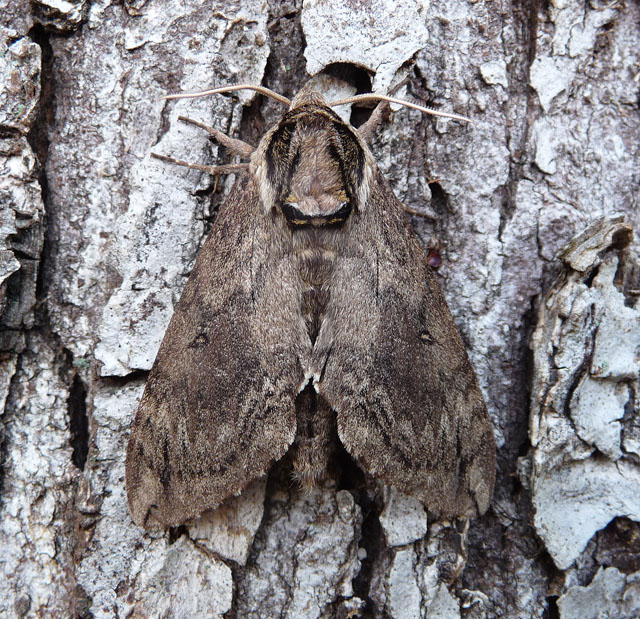
Ceratomia catalpae, Old Bridge, Middlesex County, New Jersey,
September 9, 2011, courtesy of David Moskowitz.
This site has been created by Bill Oehlke.
Comments, suggestions and/or additional information are welcomed by Bill.
TAXONOMY:
Family: Sphingidae, Latreille, 1802
Subfamily: Sphinginae, Latreille, [1802]
Tribe: Sphingini, Latreille, 1802
Genus: Ceratomia Harris, 1839 ...........
Species: catalpae (Boisduval, [1875])
|
DISTRIBUTION:
The Catalpa Sphinx, Ceratomia catalpae,
(Wing span: 2 9/16 - 3 3/4 inches (6.5 - 9.5 cm)),
flies in the eastern states from Maine west to Iowa; south to
Florida, the Gulf States, and Texas and into Mexico.
This species has also been taken in Colorado and Nebraska.
I frequently saw the larvae in New Jersey.
The upperside of the forewing is yellowish brown with no white markings, but there are indistinct black lines and
dashes. The cell spot is gray with a black outline and the upperside of the hindwing is yellowish brown with
obscure lines. The body is gray, spindle-shaped, and 30-35mm long. As a youngster, I was never terribly
impressed with the "blandness" of the adults; the larvae are certainly much more striking in appearance.
Photo courtesy of L.L. Hyche, Associate Professor, Department of Entomology, Auburn University. |
 |
FLIGHT TIMES:
Ceratomia catalpae adults fly in deciduous woodlands and around suburban
plantings of Catalpa species as two broods from April-October in northern portions of their range. In Alabama, three or four generations may
occur in a single season, and caterpillars may be present into the late fall.
Venon A. Brou confirms there are five broods in Louisiana.
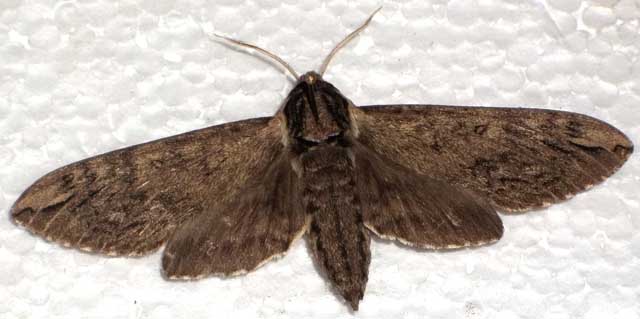
Ceratomia catalpae, Upson County, Georgia, September 24, 2011,
Rev. Redmond Farrier
ECLOSION:
Pupae probably wiggle to surface from subterranean chambers just prior to eclosion.
SCENTING AND MATING:
Females call in the males with a pheromone released from a gland at the tip of the
abdomen. Adults, which fly at night, probably do not feed.
EGGS, LARVAE, PUPAE:
Translucent eggs are small, oval, about 0.66 mm long, 0.5 mm in diameter, and whitish,
greenish, to cream-yellow in color. They are deposited in mound-like masses of 100-1000 eggs on the undersurface of
leaves with smaller clusters being deposited on twigs and branches. Eggs usually hatch in five to seven days.
Developing larvae can be seen through the shells after a few days. Photo courtesy of L.L. Hyche.
|  |
When the larvae first hatch, they are very pale, almost white, and begin to take on more black
colouration as they move into second and third instars.
Young caterpillars feed gregariously on Catalpa species (Catalpa bignoniodes and C. speciosa)
in the Bignoniaceae family, skeletonizing the foliage. Older larvae become solitary feeders and completely consume
the entire leaf. | 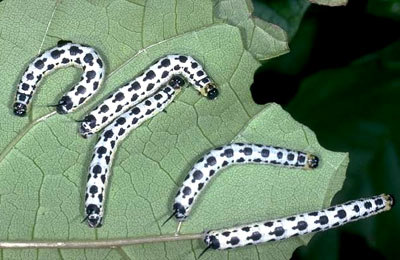 |
Colouration of mature larvae is somewhat variable, and there appear to be two primary color phases, dark and pale. In the dark phase,
there is a broad, solid black band down the back, bordered by white lines. The sides are yellowish with some black
spots and vertical lines. Image courtesy of University of Georgia. | 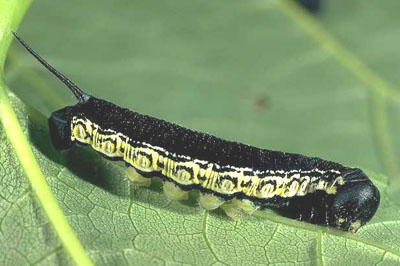
|
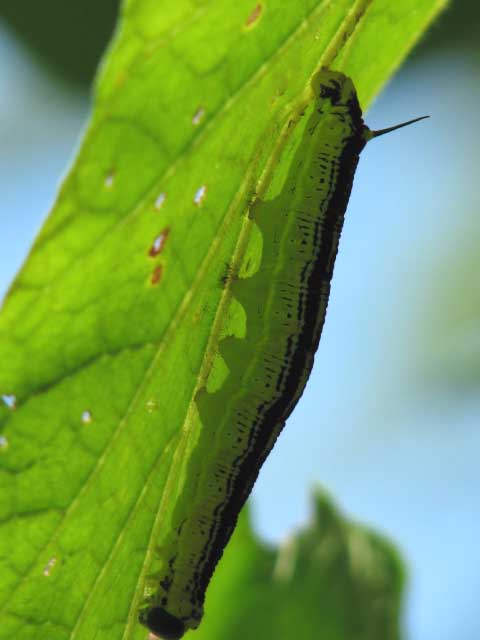
Ceratomia catalpae, Louisiana, Pike County, Missouri,
September 1, 2008, courtesy of Rhonda Murr.
In the pale phase, the solid black band is lacking. Instead, there may be black spots along
the midline of the back, and/or narrow,
broken black lines along the edges of the back. Sides of the larva are generally greenish yellow.
During periodic
outbreaks, caterpillars can defoliate catalpa trees.
In the southeast caterpillars are often used as
fish bait.
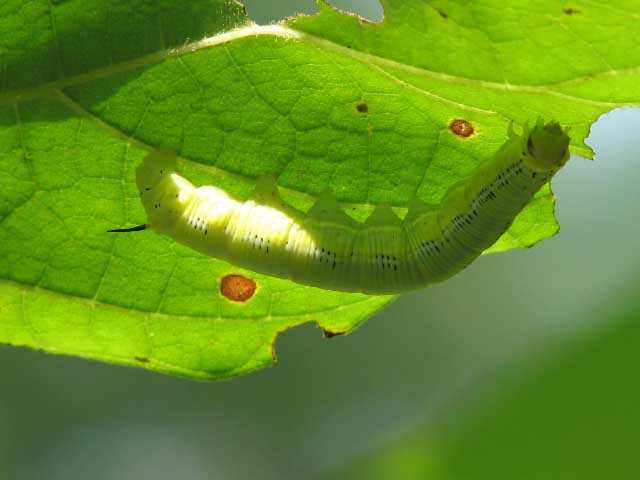
Ceratomia catalpae, pale form, Louisiana, Pike County, Missouri,
September 1, 2008, courtesy of Rhonda Murr.
Fully-grown caterpillars crawl down the tree trunk to pupate and overwinter in chambers
dug 2-3 inches into the soil. Larvae can mature
in three weeks and multiple brood pupae usually emerge in about fourteen days. |
 |
Caterpillars are often parasitized by a Braconid wasp, Apanteles congregatus, which lays its eggs inside the
caterpillar. The caterpillar eventually dies as the wasp larvae feed inside it.

Ceratomia catalpae, hopelessly parasitized, Louisiana, Pike County, Missouri,
September 1, 2008, courtesy of Rhonda Murr.
The pronunciation of scientific names is troublesome for many. The "suggestion" at the top of the page is
merely a suggestion. It is based on commonly accepted English pronunciation of Greek names and/or some
fairly well accepted "rules" for latinized scientific names.
The suggested pronunciations, on this page and on other pages, are primarily put forward to assist those who hear with internal ears as they read.
There are many collectors from different countries whose intonations and accents would be different.
I do not know the origin of the genus choice Ceratomia, but the first species assigned to this genus
is amyntor. Ceratomia may be a combination of cera (gold) and tomia (cutting). Speculation suggests the dark cuttings (streaks)
into the golden brown area of the forewing or the golden checkered fringe of that moth.
The species name "catalpae" (of the Catalpa) comes from the genus name for the larval host tree Catalpa.
Catalpa is reportedly an old Indian name.
Return to U. S. A. Sphingidae Table; links for all fifty states
Return to Sphingidae Index for North, Central and South American countries
Return to Sphingini Tribe
Visit North American Catocala; Provincial and state check lists for Canada and U.S.
Visit Saturniidae (giant silkmoths) of Prince Edward Island; livestock and supplies.
Use your browser "Back" button to return to the previous page.









